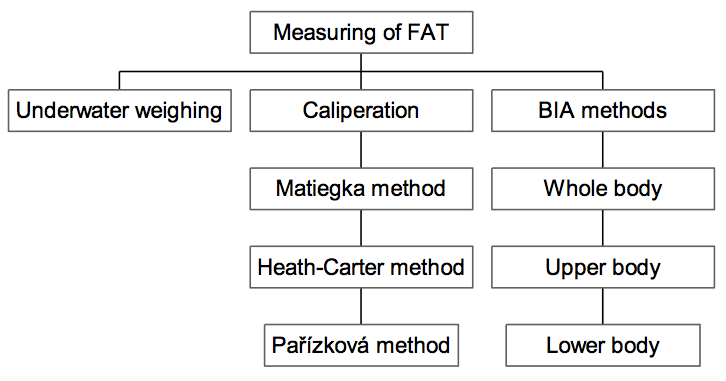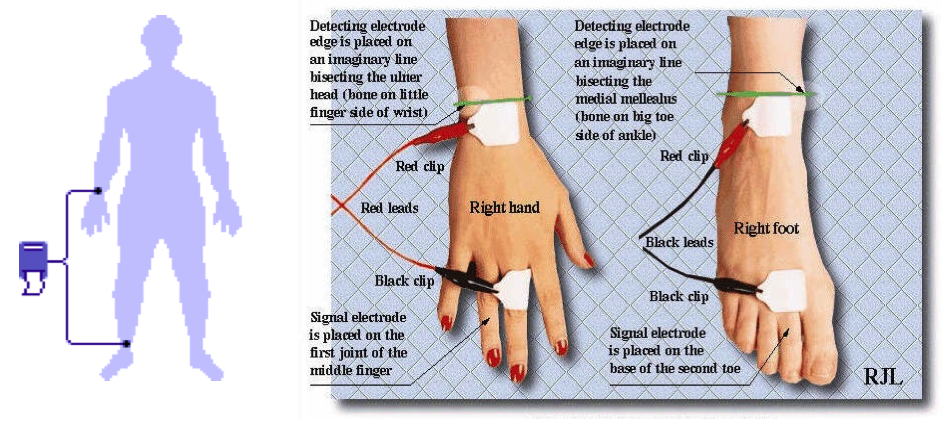
Fig. 23 Measurement structure of body composition (Vobr, 2003)

Measuring Hypodermic Fat
About 50 % of total fat in human body is stored under the skin. At many places, skin can be folded and make skinfold measurement. Other methods have also been developed apart from caliper. Such alternative approaches attempt to elliminate mistakes caused by caliper measurement – mainly different compressibility of different tissues, mostly with persons who have extreme versions of body composition.
A Caliperation – Matiegk’s Method
D = d . S . 0,13
S is body surface; d is average thickness of 6 skinfolds
(m. biceps brachii, volar side of forearm, m. quadriceps, shin, chest at the 10th rib, stomach)
B Caliperation According to Pařízková
%T♂= 28.96*log(x)-41.27
%T♀= 35.572*log(x)-61.25
x is the total sum of ten skinfolds (cheek, chin, chest I above pectoralis major, m. triceps brachii, lower angle of shoulder blade, stomach, chest II at the 10th rib, hip, thigh above patela, shin below fossa poplitea)
More Precise Ways of Measuring Hypodermic Fat
1. Radiography
Radiographic methods are considered to be most precise. They allow measuring muscle and bone intersections at the scanned place. Their use, however, is limited mainly due to X-ray exposition. The most up-to-date method is computer tomography. Its price and difficult availability, however, prevent it from being used on a wider scale.
2. Ultrasound
Ultrasound instruments utilize change of electric energy into high-frequency ultrasound energy which is transmitted in short impulses. Ultrasound waves rebound at the boundaries of tissues which differ in their acoustic qualities.
3. Infrared interaction
This method is based on absorption and rebound of light when using wave-lengths within the area of infrared light. Spectrophotometer is used for this purpose. It operates in the wave-length of 700-1,100 nanometers. This method complies well to hydrometry.
The fact that residual fat does not contain water but it forms relatively fixed fraction of fatless substance became the basis for determining body composition out of so-called Total Body Water (TBW). When calculating ATH out of total capacity of water, it is presupposed that hydration is in standard condition (73%). The amount of fat is then calculated as the difference between weight and ATH.
4. Electric Conductance – bioelectric impedance (BIA)
The basis of this method lies in the difference of spreading electricity of low intensity in different biological structures. ATH which contains big proportion of water and electrolytes is a good conductor while fat tissue has the quality of an insulator. If constant alternate current of low intensity is applied, impedance towards current spreading is evoked which depends on frequency, length of conductor, its configuration and crosscut.
This technique is based on the difference of electric conductance and dielectric qualities of ATH and fat. When its results are compared with densitometry, it appeared that the estimation was only little imprecise (3,7%). Price of this equipment, however, prevents it from being used on a wider scale.
Fig. 24 Scheme of BIA measurement (http://www.obrazky.cz/)

5. Densitometric Methods
Densitometry is based on two-component model of human body where the components are of different density. Densitometry draws from the relationship: weight = density x volume.

(Brožek, 1963)
Fig. 25 Underwater weighting (http://www.obrazky.cz/)

A. Hydrostatic scaling
Body capacity is arrived at from the difference of body weight measured in “dry” environment and under water with correction for density and temperature of water at the time of scaling. Underwater scaling is carried out with a so-called hydrostatic scales.
When scaling under water, body is relieved by air in air passages and lungs. Therefore, scaling is carried out in maximum expirium and the result is revised by the capacity of residual air (30% of vital capacity).
B. Voluminometry
A method similar to hydrostatic scaling, what is measured, however, is the real capacity of water buoyed by submersible object. It requires measuring residual air as well.
C. Plethysmography
A method based on sucking air out of a jar of known capacity (or more precisely, on changes of pressure during sucking).
6. Biophysical Methods
They utilize facts gained by chemical analyses of various tissues of human body and with the help of whole-body computers also determine weight of individual tissues on the basis of contents of individual detectible elements. These methods are based on discovering total body kalium, calcium or nitrogen.
7. Biochemical Methods
They utilize biochemical processes in human body. On the basis of degradation of some substances, it is possible to determine body composition.
1. Creatininury: determines the amount of creatinine in urine (1g od creatinine /24 hrs is equal to 20 kg of muscles).
2. Overall plasmatic creatinine: 1mg is equal to 0.88-0.98 kg of muscles.
3. Secretion of 3- methylhistidine: it illustrates degradation of muscle proteins.